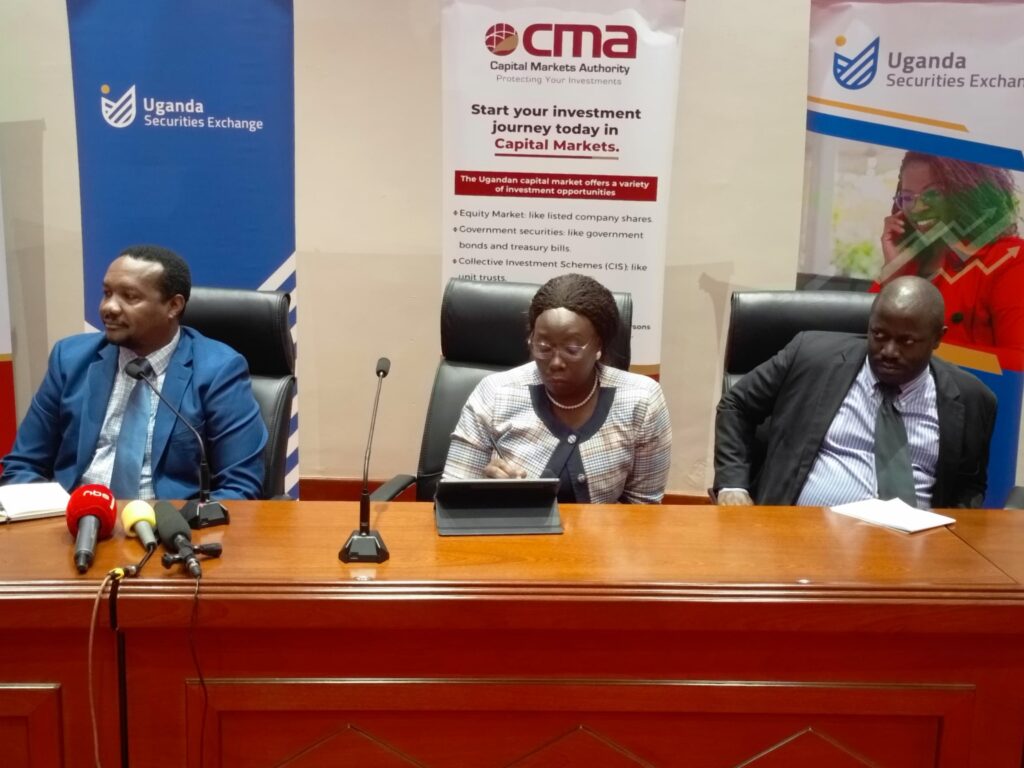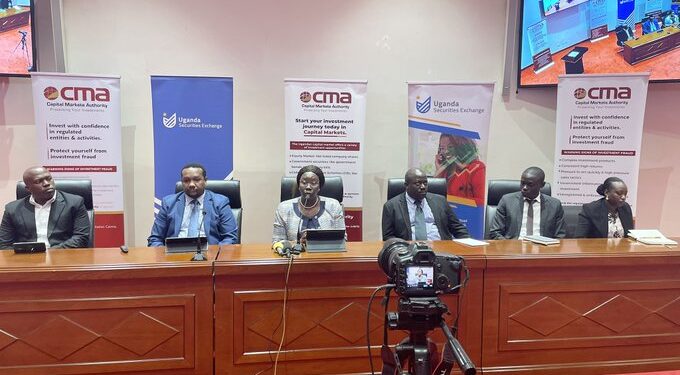Uganda’s capital markets are gaining momentum as the Uganda Securities Exchange (USE) and the Capital Markets Authority (CMA) reported strong performance and unveiled wide-ranging reforms during a joint quarterly press briefing held at the Uganda Business Facilitation Centre.
The Chief Executive Officers of both institutions—Mr Paul Bwiso (USE) and Mrs Josephine Okui Ossiya (CMA)—outlined critical developments in market activity, regulatory improvements, and future strategies aimed at deepening financial inclusion and positioning capital markets as a key driver of economic transformation.
Market Indices Soar on Improved Investor Confidence
USE CEO Paul Bwiso reported that the All Share Index (ALSI) grew by 21.6%, while the Local Company Index (LCI) posted an impressive 31.17% increase in Q1 2025. The gains were fueled by strong performances on counters such as MTN Uganda, Stanbic Uganda Holdings (SBU), Bank of Baroda Uganda (BOBU), and Quality Chemicals Industries Ltd (QCIL).
“These results reflect renewed investor confidence, increased dividend declarations, and stronger earnings among listed companies,” Bwiso said. “We are also witnessing a significant impact of technology on participation.”
The Exchange recorded a turnover of UGX 16.9 billion from 122.5 million shares traded across 2,165 deals. Active Securities Central Depository (SCD) accounts surpassed 262,000, buoyed by simplified onboarding and growing public interest.
Macroeconomic Stability and Dividends Driving Growth
Bwiso attributed the market’s buoyancy to macroeconomic stability. The Central Bank Rate remained at 9.75%, inflation hovered between 3.6% and 4.2%, and the Ugandan shilling appreciated slightly against the US dollar. These conditions, he said, laid the foundation for a projected 6.0% to 6.5% economic growth in FY2024/25.
“About 80% of listed companies declared dividends last quarter,” Bwiso noted. “Dividends remain a powerful tool for attracting retail investors who are looking for long-term financial growth and income.”
USE Launches EAC Top 20 Index and Expands into Agriculture
In a move toward regional integration, Bwiso announced the launch of the EAC Top 20 Index, tracking top-performing companies across Uganda, Kenya, Tanzania, and Rwanda.
“This regional benchmark is a step toward deeper East African capital market integration. It will also lay the foundation for future Exchange-Traded Funds (ETFs), providing easy access for investors to diversified portfolios,” he explained.
Turning to commodities, he highlighted the progress of USE COMMEX, a subsidiary commodities exchange supporting trade in maize, sesame, beans, and paddy rice. Four warehouses have been onboarded, and 28 tons traded in the pilot phase.

“We are building a viable ecosystem involving brokers, farmers, collateral managers, and financial institutions to make agricultural trade more transparent and efficient,” Bwiso added.
CMA Announces Regulatory Overhaul and Product Expansion
CMA CEO Mrs Josephine Okui Ossiya outlined sweeping reforms designed to position Uganda’s capital markets as a dynamic platform for raising long-term financing for both the public and private sectors.
“By fostering a robust regulatory environment, we can unlock capital that powers key sectors like agriculture, tourism, manufacturing, and services,” she said.
Ossiya announced the development of regulations for Shariah-compliant products and Green, Social, and Sustainability-Linked Bonds, set for rollout in the last quarter of 2025. These products will diversify Uganda’s capital market offerings and attract both ethical and impact investors.
She also revealed that CMA has gazetted new rules, including the 2025 Partnership Regulations, enabling private capital funds to register as Limited Liability Partnerships (LLPs)—a move expected to spur growth in private equity and venture capital funding.
Other key regulations now in effect include: the conduct of Business Regulations, licensing and Offer of Securities Regulations and Corporate Governance Regulations. “These reforms are aligned with global best practices and will increase the availability of capital for startups and scaling enterprises,” Ossiya noted.
Fostering Innovation and Compliance
The CMA is set to launch regulatory sandbox guidelines by Q3 2025 to support fintech innovation in capital raising. “This sandbox will enable controlled testing of novel financial solutions, boosting market inclusivity and innovation,” Ossiya explained.
Meanwhile, both USE and CMA are reinforcing compliance. Bwiso confirmed that UMEME’s temporary suspension from trading was necessary to prevent insider trading and maintain fair market conditions. He also announced that ESG (Environmental, Social, and Governance) guidelines would be finalized and approved by May 2025.
“We are tightening rules and increasing penalties for non-disclosure. Timely public information is essential to maintain investor trust,” Bwiso emphasized.
Looking forward, both CEOs expressed commitment to: increasing financial literacy and investor education; enhancing USE’s Self-Regulatory Organization (SRO) capacity; deepening local investor participation; and supporting the Ten-Fold Program and National Development Plan IV (NDP IV) through innovative financing.
“The competition is stiff, especially from high-yield government securities,” Bwiso concluded. “But capital markets offer long-term value through dividend growth, equity appreciation, and portfolio diversification.”








